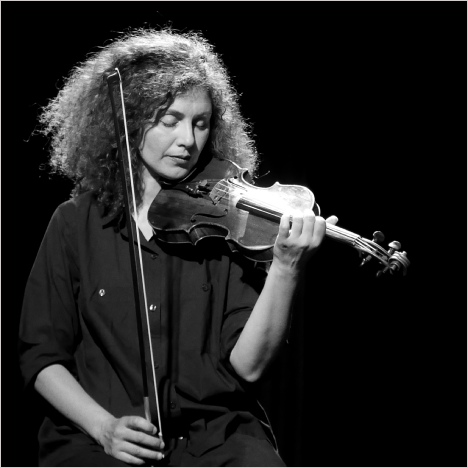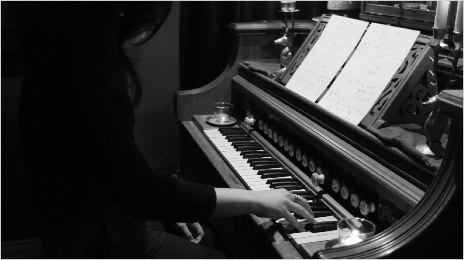Another Timbre TimHarrisonbre




at204 Biliana Voutchkova & Sarah Davachi
‘Slow Poem for Stiebler’ (2021/22) 48:44
Biliana Voutchkova, violin & voice
Sarah Davachi, reed organ
An extended piece jointly developed by Sarah Davachi & Biliana Voutchkova,
which takes short moments from Ernstalbrecht Stiebler’s composition ‘Für
Biliana’ and expands them hugely into hovering, slowly circling harmonies.
The project was supported by a virtual scholarship from Goethe Institut.
Cover artwork by Lena Czerniawska
Interview with Sarah Davachi & Biliana Voutchkova
How did 'Slow poem for Stiebler' come about?
SD: 'Slow poem for Stiebler' came about initially in 2020 with the release of 'Für Biliana', written for Biliana by the German composer Ernstalbrecht Stiebler. I had been a long-time admirer of Stiebler's music and reached out to Biliana to express my enthusiasm for the release – Biliana and I had originally met in 2018 when she and Cat Lamb accompanied me on strings in a concert I gave in Berlin. Biliana then reached out to me a few months later to see if I would like to work on a sort of re-composition of 'Für Biliana', perhaps something that we could perform together. We received a grant from the Goethe Institut to support the project and began working in earnest in the summer/fall of 2021. We did some back and forth sharing of ideas and score material, and in February 2022 Biliana did a rough presentation of some of the material in Berlin. In April 2022 we organised a recording session and concert as part of a residency Biliana was doing in Los Angeles, so we formalised the structure of the piece that you hear in the recording for that, although the piece is by design somewhat flexible and modular.
BV: From my side, the idea of inviting Sarah for this collaboration came very naturally. When she mentioned that she is an admirer of Stiebler's music, I immediately connected what was evident - my wish of collaborating with her, and engaging further with Ernstalbrecht's pieces in a different way. I never did a re-composition of an existing piece before. I was eager to see where our common appreciation, inventiveness and the completely different parameters settled from the very beginning would bring us.
So the source of the piece is taken from Stiebler's 'Fur Biliana', but how did you transform the original material?
SD: We were thinking of it as a sort of remix or re-composition of Stiebler’s original piece. From my side, I was really drawn to the simplicity and beauty of the harmonies and intervals, as well as the circular non-narrative movement of the piece as a whole. I wanted to slow that down quite a lot and really luxuriate in the harmonies. So essentially we took different sections of the piece and extended them over a much longer period of time and broke them apart much more, made them more circular, and added in a kind of heterophony into the texture with the harmonizing of organ and voice in addition to the violin. We thought that it would be interesting to make the piece "modular", so we can choose different sections and order them in different ways to create a completely different structure of a really variable length. Each section is fully notated, but of course the pacing is quite variable with us moving through the piece intuitively while also listening closely to what the other person is doing and noticing when they've moved through different notes or intervals. It's a piece that focuses on simplicity and listening, which I think is reflective of Stiebler's approach.
BV: I just want to add a few more words about our first in person session in Berlin, in October 2021. We had a long talk, listened and reflected on the original piece and some other music which we found relevant for the project, and tried out various combinations of voice/violin textures referring to the ‘Für Biliana’ score. My most particular interest was to find ways of interweaving violin, voice and organ alongside subtle field recordings. I think our exchange that day was very fruitful. Many ideas which we followed appeared then for the first time - for example, the wish to have a flexible structure which allows variations.
Sarah, how much of your previous music works in the same way (ie notated, but allowing a lot of freedom in interpretation)?
SD: A lot of my music is written this way. It started just as a convenient way of notating my live solo performances early on – I would give myself rough parameters of things that I should be doing at certain times and for how long I should be doing them before moving onto the next thing, and over the years I found that that was actually a really meaningful way of performing music, to be able to listen actively in the moment and really respond or change things acoustically, to pay attention to and process what's happening at any given moment. Each performance ends up being a bit different because of how you're feeling or what the space accommodates and where it takes you, and I find that really interesting. A lot of the chamber music that I compose also incorporates a fair amount of decision making on part of the players in terms of which notes they play, when they play them, and for how long they are held – I'll give a couple options, but I think it's really interesting when the players can decide in the moment how things are going to sound. I like the idea of music that changes with each iteration, and I believe strongly in the concept of iteration as a form of expression, things that are the same but different. I find it depressing that so much notated music tends to focus on the notes exactly as they are on the page, with musicians often reading the music and just checking out mentally – I want to give musicians the opportunity to listen while they perform, to be more active members in the acoustic space that they are creating. And I think that sensitivity comes through to the listener in a beautiful way as well.
Could you tell us a bit more about your background in contemporary music?
SD: I grew up playing piano through the Royal Conservatory of Music in Canada, very institutionalised, learning the canon. At a certain point, I found myself particularly interested in chords and harmonies – I would pause on certain chords that I was playing just to prolong the experience and my enjoyment of the sound, and then I began to wonder about music that could be based on this vertical harmonic principle, which I found early on in the minimalist compositions of people like La Monte Young and Éliane Radigue. So my initial interest in writing contemporary music was to chase this feeling of intimacy with sound, of being within sounds that I found to be beautiful or moving in some way. I found myself drawn to electronic music early on in part because of the flexibility it offered, and in part because of the control that it gave me. In electronic music composed in the studio, I could be both composer and performer and I didn't have to worry about how to explain ideas that I was still trying to make sense of in my own head to someone else. Once I felt a bit more comfortable in that sonic world, it was very exciting to be able to branch out more and start to incorporate acoustic instruments as well as different ideas about tuning and timbre and texture. I worked initially in the form of electroacoustic composition – recording acoustic instruments at various held tones and then editing those recordings and processing and assembling them in the studio into acousmatic pieces meant only for playback. I still work that way a lot of the time, and occasionally I'll create an acoustic chamber piece through those means and only notate it after the fact. Through my work with the organ, which I became interested in while I was doing my MFA at Mills College, I was able to come out of the studio a bit and explore the world of acoustic composition more directly, on account of having a special relationship with keyboard instruments. The relationship between composer and performer, and the dialogue and possibility for interpretation, is so sacred to me and I'm really enjoying splitting my time between studio-based works that are private and involve only me, as well as flexible acoustic works that I can hand off to ensembles to interpret and bring new life to. As I said earlier, iteration is a really important concept to my work and I've become more interested in the formalized and notational aspects of contemporary practice as a way of constantly moving closer to a certain feeling, of how different articulations of the same feeling can have vastly different meanings.
BV: Can I add something? Strangely enough, this question made me think of my present, wondering why and how I arrived here after a pretty solid early classical / later on contemporary music education. I am now mostly interested in creating new work, collaborative or solo, composed or improvised, acoustic, electro-acoustic or audio-visual, but always allowing space for spontaneity and response to the current moment. I connect to intuition and the knowledge locked within us, searching for the circumstances which enable them to arise to the surface. Through sound and deep listening, I engage with the ephemeral, transient, the dreamworld, with various kinds of verbal and non-verbal communication and connectivity between people, places and all of life, allowing the occurrence of touching and meaningful experiences.
Biliana Voutchkova & Sarah Davachi

Sarah Davachi © David Reiman
Biliana Voutchkova © Christina Marx